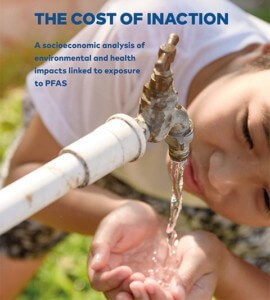May 2019: Here Today, Here Tomorrow
In this edition:
- A Tribute to Bob Luedeka
- Beginning of the End for Forever Chemicals
- Stuck with the Bill for Non-Stick
- Houston Waterways Bear the Brunt
- Please Welcome Our New Science & Policy Fellow, Seth Rojello Fernández
- CALENDAR
I hope you are enjoying spring. To begin on a sad note, please see below my tribute to my good friend Bob Luedeka, who passed away last month after a long battle with cancer. Bob, the executive director of the Polyurethane Foam Association, was a strong advocate for stopping the use of toxic flame retardants in furniture.

Last week, at our seventh annual Six Classes Toxics Reduction Retreat in the Santa Cruz mountains, leaders from business, academia, government, and NGOs, who are passionate about reducing toxics, came together to share their challenges, successes, and make future plans for a healthier world (see photo). Here are a few favorites from an activity on slogans about PFAS:
– PFAS: Here today, here tomorrow
– Rain is fleeting; PFAS are forever
– When it starts raining oil, then I’ll need PFAS in my umbrella
– Nix the C6
Please join our contest and send your favorite short slogans on PFAS, flame retardants and/or others of the Six Classes to [email protected]. We will share the favorites in our next newsletter and send each winning slogan author a colorful Green Science Policy bag as a thank you.
Also last week, the International Residential Code (IRC) Action Committee ruled against our joint code proposal to allow a choice of foam plastic insulation without flame retardants below a concrete slab foundation. In January, we had celebrated when the California Building Standards Commission ruled unanimously to update its codes to allow such flame retardant free-insulation.
Insulation without flame retardants has been safely used in Scandinavia and Spain for years. This IRC ruling was a victory for the chemical producers who testified against the proposal and a setback for the firefighters, architects, scientists, and public health advocates who would like to see an end to this unnecessary requirement for toxic flame retardants.
For interesting reading in support of such a code change, check out the Science article, “Toward fire safety without chemical risk” by Jacob deBoer and Heather Stapleton.
Finally, I would like to hire a part-time personal assistant who is a creative problem solver and has had least three years of administrative experience, preferably in a fast-paced nonprofit environment. Please email me if you might know someone appropriate for this position in the Berkeley.
The 37th annual Berkeley Himalayan Fair is next Saturday and Sunday May 18-19, in Live Oak Park in North Berkeley. Please stop by my booth across from the stage and say hello if you come to the Fair.
Kind regards,
Arlene and the Green Science Policy team
A Tribute to Bob Luedeka
by Arlene Blum

I am sad to share the loss of Bob Luedeka of the polyurethane industry, a leader for reduced toxics. Our 13 years of sharing the science and policy of flame retardants began when I met Bob in March 2006 at a green chemistry meeting in Oakland. Bob’s efforts directly contributed to updating the California furniture flammability standard so that flame retardants are no longer needed in our nation’s furniture and children’s products. Changing this standard has made every home in America healthier and it would never have happened without Bob’s passion and hard work. When Bob learned that foam makers would no longer be required to use toxic flame retardants, he cried with happiness that foam industry workers and everyone else would be healthier.
During his illness Bob always remained optimistic that he would recover and put his considerable energy and creativity into making sure that others were not exposed to toxic chemicals.
Bob was a man of great passion and accomplishment who led the way towards healthier foam and a healthier world. He is greatly missed.
Beginning of the End for Forever Chemicals
by Tom Bruton and Arlene Blum

Attorney Rob Bilott has filed a lawsuit against all the producers of PFAS on behalf of everyone in the U.S. with these chemicals in their bodies – which is pretty much everyone. In his eloquent response to the chemical industry request to dismiss his claim, Rob wrote, “Defendants created chemical compounds that do not exist in nature and exposed the world to them without warning, without asking permission, without regulation, without concern for the damage they were doing…Defendants used the bodies of hundreds of millions of Americans as their own toxic waste dumps without their knowledge or permission. The nature and extent of the resulting injury is unprecedented in scope, severity,
and sheer brazenness.”
While the production and use of PFAS continues to grow, the era of chemical companies discharging these substances into the environment unnoticed and unregulated may be drawing to a close. In recent weeks, New Jersey, a state that has been home to several PFAS production facilities, announced three measures designed to hold producers liable for contamination:
- A directive ordering five manufacturers to provide detailed information about
where the chemicals are used, stored, transported, discharged and disposed of, and to pay for clean-up. - Four lawsuits against three companies for damage to the state’s natural
resources. - The New Jersey DEP proposed adding PFOA and PFOS to the state’s list of
hazardous substances.
Learn more in Sharon Lerner’s excellent piece here. New Jersey is just one of many states taking action to address PFAS in the absence of meaningful federal regulation. Check out Safer States’ page for a list.
And here’s some global good news: last week more than 150 counties participating
in the Stockholm Convention on Persistent Organic Pollutants unanimously approved
a global ban on the use of perfluorooctanoic acid (PFOA).
Stuck with the Bill for Non-Stick
by Gretta Goldenman

All of us living in industrialized countries have PFAS in our bodies from consuming contaminated water and food, and from living with products treated with these toxic chemicals. We did not consent to this exposure. How much is it costing us? A recent Nordic Council study, The Cost of Inaction: A socioeconomic analysis of environmental and health impacts linked to exposure to PFAS, estimates the very high cost of harm to human health and the environment from PFAS exposure in Europe.
Non-health costs, e.g., treatment of contaminated drinking water, are estimated to range between 16.9 and 170.8 billion EUR over the next 20 years. The estimates are based on actual costs of PFAS contamination incurred by communities and industries in the U.S. and Sweden.
Health-related costs may be even higher. Epidemiological research on PFAS exposures of workers and communities with contaminated drinking water indicates that annual health-related costs range between 52 and 85 billion EUR each year.
The study, led by Green Science Policy Board of Directors President Gretta Goldenman, concludes that these are underestimates, because data is lacking concerning the long-term health impacts of PFAS exposure. These costs are not paid by the industries profiting from making and using PFAS. Rather, they are borne by taxpayers and by affected citizens. This excellent report provides further motivation to reduce the unnecessary use of these “forever chemicals.”
Houston Waterways Bear the Brunt
by Alex Young

“Don’t mess with Texas.” The anti-littering campaign turned state rally cry needs some more oomph behind it these days. Intercontinental Terminals Co. (ITC), a chemical storage terminal used by Exxon, Chevron, and others, has again caused an environmental and human health crisis at its Deer Park facility just east of Houston, TX. Deer Park’s history is intertwined with the oil and chemical industries that have long been located there. For instance, it is home to the deep-well injection facility where Chemours ships PFAS waste that it can’t legally dispose of in the Netherlands.
On March 17th, one of ITC’s storage tanks caught fire and released plumes tanks caught fire and released plumes of black smoke that blanketed the Houston area for a week, prompting school closures, shelter-in-place warnings, and public outrage. A breach in a containment wall allowed petrochemicals and PFAS-containing firefighting foam to leak into the surrounding bayous and shipping channels. Aerial photos from the site show slicks of black fluids and swirls of firefighting foam travelling down the bayous and into Galveston Bay. The incident led to dozens of animal deaths, and tests confirmed the presence of high levels os toxic PFOS in the surrounding water bodies. The results from the water testing are publicly available and the steps for access are listed below.
ITC is a known polluter, and incidents at the Deer Park facility have resulted in penalties for environmental violations since 2009. In February 2018, ITC’s former hazardous waste specialist accused the company of using Hurricane Harvey as an excuse to dump over a million gallons of waste into floodwaters. This string of offenses has led Texas lawmakers to call for revisiting the lax regulations that allow these environmental nightmares to continue.
Water sampling data can be difficult to find, so here’s how to access the Texas CEQ’s data (here). Click on “Water Sampling” in the top right corner of the interactive area. Scroll to a map with blue/black circles and squares, each of which link to the sampling results for a location. The database shown for each marker is a list of all the sampling dates with all analytes detected. Up to 1300 ppt of PFOS and 7000 ppt of other PFAS were found: not healthy for the wildlife of the bayous.
Please Welcome Our New Science & Policy Fellow, Seth Rojello Fernández

We are pleased to welcome Seth Rojello Fernández to the GSP team as our new Science & Policy Fellow. Seth received his M.S. in Environmental Toxicology from the University of California Riverside in 2019, where he worked with David Eastmond assessing organohalogen and organophospate flame retardants for their health hazards. He holds bachelor degrees from Texas A&M University-Commerce in both Political Science and Environmental Science.
CALENDAR
May 14-17, 2019: International Symposium on Flame Retardants (BFR 2019)
- Location: Montreal, Quebec, Canada
- Joe Charbonnet will be presenting in and chairing the Friday session on regulation.
May 21-22, 2019: Emerging Contaminants in the Environment Conference
- Location: Champaign, IL
- Tom Bruton will be giving a keynote and participating in a panel. Learn more here.
July 24-26, 2019: Oregon Assoc of Clean Water Agencies (ACWA) Conference
- Location: Mount Bachelor Village Resort, Bend, Oregon
- Arlene Blum will be giving the opening keynote on the Six Classes of chemicals of
concern.
Receive Updates By Email
Subscribe to our monthly newsletter and get these updates delivered right to your inbox!